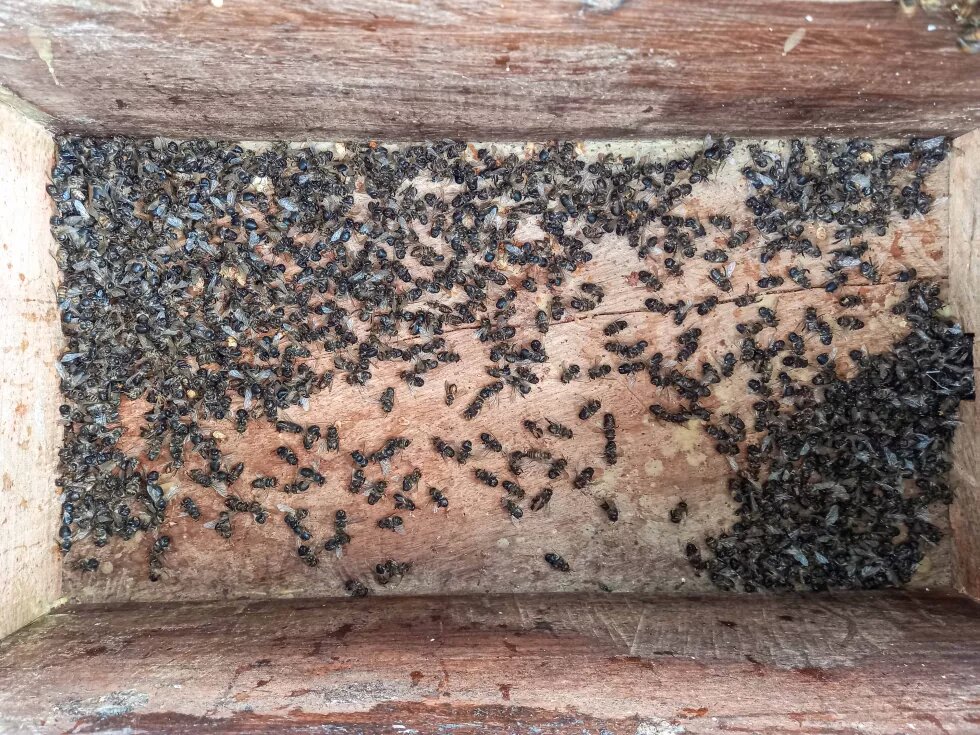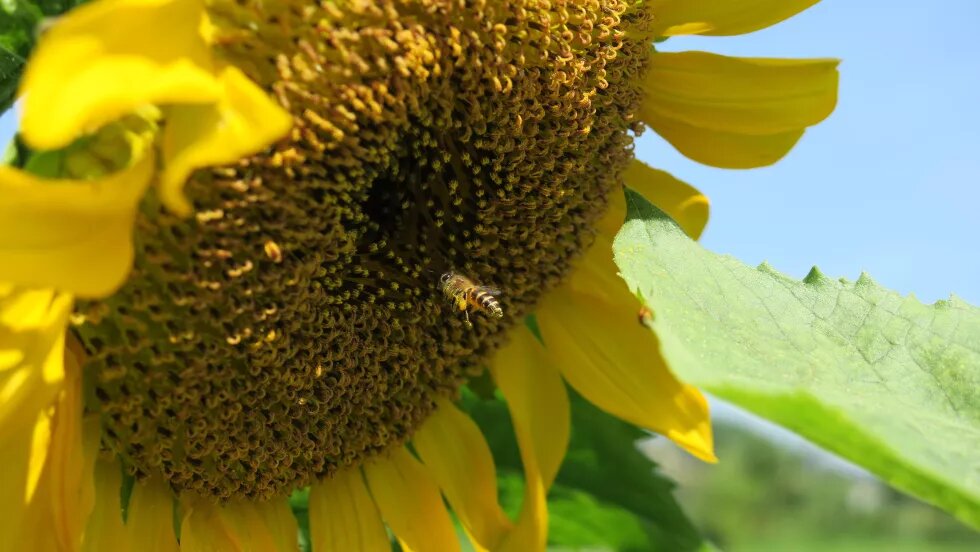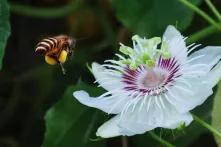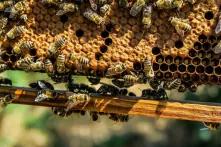
Most beekeepers have, at one time or another, found themselves confronted with the painful experience of finding a carpet of dead bees on the floor of one of their hives, or of observing bees in front of their hives exhibiting tremors, uncoordinated movements and convulsions; all signs of insecticide poisoning.

While most of us agree that pesticides are not great friends of bees, our understanding of the interactions between pesticides and bees often does not extend far beyond a vague idea. We hope that this article will contribute to bringing elements of a response to a couple of questions related to the impacts of pesticides on bees.
Are pesticides a threat for bees?
Pesticides are substances that are meant to control pests. As so, they can be classified by the group of organisms they target: e.g., herbicides against weeds, fungicides against fungi, insecticides against insects, acaricides against acarians, and so on.
Though bees are not specifically targeted by any particular pesticides because they are not designated as pests of any crop, they are nonetheless collateral victims of the use of pesticides. No pesticide has been specifically designed to control bees but unfortunately most pesticides are not only toxic to the group of organisms targeted and it is estimated that over 98% of sprayed insecticides reach a destination other than their target species [1].
Are all pesticides similarly dangerous to bees?
Not all pesticides have the same degree of toxicity to bees. In accordance to the tenet of toxicology, “the dose and the time of exposure makes the poison”, to evaluate the toxicity of a pesticide on bees, we need to answer two questions: (i) how much pesticide is needed to kill bees and (ii) how long the pesticide can remain in the environment?
The answer to the first question is given by the Acute Toxicity of a pesticide, also called the Lethal Doses 50 (LD50), which is the quantity of a pesticide that kills 50% of the bees exposed. The smaller the LD50, the more toxic the pesticide. As a reference, the Environmental Protection Agency (EPA) in the US considers any pesticides with a contact LD50 lower than 11µg/bee as toxic to bees. The LD50 highly differs from one pesticide to another. For example, the infamous Fipronil, a systemic insecticide, is 50 times more toxic to bees than beta-cyfluthrin and 5,000 times more toxic than the famous DDT.
The answer to the second question is given by the Half-life of a pesticide, which is the time required for half of a pesticide to disappear from the environment. Basically, at the end of one half-life, 50% of the pesticide will remain, 25% after two half-lives and so on. Pesticide’s persistence in the environment varies from a couple of days to several years (almost 17 years for DDT!).
What happens when bees are exposed to sub-lethal doses of pesticides?
Doses lower than the LD50 are called sub-lethal. They may still kill bees; just less than 50% of the bees exposed. Sub-lethal doses can also disturb the performance of individual bees, or worse, that of the colony thus decreasing its chances of survival. These are called chronic effects.
What happens when bees are exposed to several pesticides simultaneously?
Some pesticides can become more harmful in the presence of other pesticides. The toxicity of certain insecticides can be enhanced in the presence of other pesticides which act as synergists; this is commonly referred to as cocktail effect. For example, a fungicide, with a low toxicity to bees, can inhibit the detoxification system in bees, thus decreasing their capacity to eliminate a toxic insecticide [2, 3].
How bees get intoxicated by pesticides?
Bees can get intoxicated by agricultural pesticides by touching the pesticide (contact exposure) or by ingesting it (oral exposure). Regarding contact exposure, bees may be intoxicated while crawling over sprayed surfaces of plants or flying across treated fields. Droplets of pesticides or contaminated dust particles can also be transported by wind and affect bees or bee colonies up to several hundreds of meters away from the crop. Bees may also carry the pesticide to their nest either as dust particles or droplets attached on their body. Inside the nest, larvae and bees may be killed by contact with contaminated bees or bee wax. When forager bees are feeding on contaminated pollen or nectar (oral exposure), they may die, if exposed to lethal dose, but they may also intoxicate other bees, larvae as well as the queen by sharing contaminated food.
Why systemic insecticides are called “bee killer pesticides”?
Systemic insecticides, a specific group of pesticides, comprising in particular the infamous neonicotinoids, sadly famous for their prominent role in colony collapse disorder are particularly harmful to bees. Neonicotinoids are neurotoxins, synthetically similar to nicotine. First appeared on the pesticide market in 1995, neonicotinoids are now the most widely used insecticides in the world [4]. Neonicotinoids may be applied as spray or as coated seeds (the insecticide is around the seed). As they are water-soluble, systemic insecticides are absorbed by the crop plant as it grows and their residues are present in all parts of the plant, including flowers (nectar and pollen) [5]. When bees feed on crops treated with systemic insecticides or crops grown from coated seeds, they ingest pesticides residues.
Systemic insecticides pose a risk to bees, not only because of their particular mode of action but also because of their very high toxicity and long persistence in the environment. Most neonicotinoids have a LD50 in the range of 4ng. Their toxicity to bees is 3.000 times higher than the limit set up by the EPA for bee-toxic pesticides. One teaspoon of neonicotinoids would be enough to kill 1,250,000,000 bees [5], which corresponds to 25,000 colonies of the Western honey bee, Apis mellifera, 50,000 colonies of the Eastern honey bee, Apis cerana, or 250,000 colonies of the red dwarf honey bee, Apis florea. Early July 2021, a beekeeper in Cambodia had the sad surprise to find his 70 bee colonies killed in a longan orchard following a Fipronil (a systemic insecticide) spray by the orchard owner.
But this is not all: the threat of systemic pesticides for bees is not limited to the crop plant! As only a small part of the insecticide is absorbed by the crop, the remaining is absorbed by other plants or ends up in water bodies. As a result, not only the crop plants but also the weeds and bushes that grow in or near the field as well as water bodies are contaminated by systemic pesticides and thus potentially deadly to bees!
Systemic insecticides are also famous for their chronic effects on bees and bee colonies. Sub-lethal doses of neonicotinoids may for example affect the capacity of foragers to collect pollen and nectar, weaken bee’s immune system, thus predisposing them to diseases, reduce the queen’s ability to lay eggs and drone’s fertility.
Do bee products such as honey, wax and bee pollen contain pesticides?
Pesticides are also present in bee products: most of the honeys, wax sheets and bee pollens worldwide are contaminated by pesticides. A research conducted in 2017 by the University of Neuchâtel on 198 honey samples from all over the world [4] found that: (i) three quarters of honeys worldwide contained neonicotinoids, (ii) half of them were contaminated by pesticides cocktails, (iii) though concentrations were below the maximum authorized for human consumption they were alarming for bees (half honeys worldwide contained pesticides at concentrations above toxicity limits for bees). Other bee products such as wax and pollen are also contaminated. While honeys commonly contain more types of pesticides, pesticides concentrations are higher in pollen and wax [6, 7].
Are pesticides also impacting wild colonies of Asian native honey bees?
While the impact of pesticides on managed colonies is partly documented thanks to reports from beekeepers, very little is known on the damages of pesticides on wild colonies of Asian native honey bees. It does not mean that Asian native honey bees are not impacted, but rather that this impact is not monitored. We must take this fact into account. Aside from the risk of foragers intoxication by contaminated flowers; a risk to which managed colonies are also exposed; native honey bee colonies nesting in or in the vicinity of agriculture fields are particularly exposed to pesticides sprays. Indeed, unlike managed colonies, wild colonies of native honey bees can't be moved by beekeepers prior to pesticides sprays. The red dwarf honey bee, Apis florea, a small honey bee, common in farming areas that hang its nest on small branches, is particularly at risk of destruction by pesticides sprays.
“Robot bees” and “Frankenbees”
Ongoing research programs are exploring the use of drones, “robot bees”, and pesticides resistant genetically modified bee, “Frankenbees”, to allow pollination in pesticides contaminated environments [8]. Though these new technologies might contribute to secure pollination for food production, they might also have adverse effects. They might indeed encourage the uses of more pesticides and thus increase native pollinators mortality. In addition, these new technologies will not replace native bees for the pollination of natural ecosystems.
What could be done to mitigate the impact of pesticides on bees?
The impact of pesticides on pollinators in general and bees in particular in Southeast Asia could be mitigated by the introduction of Pesticides Application Best Management Practices. Best Management Practices for pesticide users may consist in a set of practical measures at farmers disposal such as: (i) applying pesticides only when needed, (ii) avoiding bee-toxic pesticide use during bloom, (iii) if the use of bee toxic pesticide during bloom cannot be avoided, avoid applying the pesticide during the main foraging time and preferring bee-toxic pesticides with short residual toxicity.
The adoption of best management practices will require a fundamental change in agricultural practices. As a consequence, the introduction of this new farming approach will inevitably face a certain degree of resistance from farmers. This paradigm shift will therefore necessarily require the definition of practical and concrete solutions and awareness raising on the importance of pollinators for agriculture and the adverse effects of pesticides on native pollinators.
How beekeepers and farmers can become the best advocates of Pesticides Application Best Management Practices
Interestingly, the introduction of small-scale beekeeping to farmers contributes to encouraging them to adopt more sustainable farming practices and to advocate for Pesticides Application Best Management Practices among their respective communities. In the northern Laos, the province of Oudomxai, beekeepers (AESBO association) play an active role in refraining from the use of pesticides in their villages. Following the loss of one of her colonies by pesticide poisoning, a recently trained beekeeper, in the province of Siem Reap, Cambodia, made the decision to stop applying insecticides on her vegetables.
__
Eric Guerin is French biologist, expert on beekeeping and Asian native bees conservation. Based in Southeast Asia since 2008, he has made a special effort to document the work of honey hunters and rafter beekeeping communities, diffusing sustainable honey collection practices, introducing small-scale beekeeping as part of organic agriculture development, raising awareness on native honey bee conservation, and supporting optimization of forest honey value chains. He is based in Siem Reap, Cambodia.
The views expressed in this article are not necessarily those of Heinrich Böll Stiftung.
References
|
[1] |
""Tyler Miller G., Sustaining the Earth: An Integrated Approach, Thomson/Brooks/Cole, 2004, p. 211–216.". |
|
[2] |
"Iwasa T, Motoyama N, Ambrose JT, Roe RM. Mechanism for the differential toxicity of neonicotinoid insecticides in the honey bee, Apis mellifera. Crop Protection 2004; 23(5): 371–8.". |
|
[3] |
"Pilling ED, Bromleychallenor KAC, Walker CH, Jepson PC. Mechanism of synergism between the pyrethroid insecticide λ-cyhalothrin and the imidazole fungicide prochloraz, in the honeybee (Apis mellifera L.). Pestic Biochem Physiol 1995; 51(1): 1–11.". |
|
[4] |
"Aebi A., Mulhauser B., Glauser G., Mitchell E.A.D. Miels et néonicotinoïdes, quelles implications pour les apiculteurs? Abeilles & cie 5-2017 n°180 : 28-30.". |
|
[5] |
"Goulson D. Les néonicotinoïdes nuisent-ils réellement aux abeilles ? Abeilles & cie 3-2017 n°178 : 14-17". |
|
[6] |
"Wiest L. (2011) Development of a multi-residue routine analysis of 80 pesticides in honeys, honeybees and pollens, Apimondia 2011, Buenos Aires.,," " http://www.apimondia.com/congresses/2011/Technology-Quality/DEVELOPMENT… %20Laure%20Wiest.pdf. |
|
[7] |
"BRUNEAU E. Des produits contaminés, un nouveau défi pour demain. 3-2012 n°148 abeilles & cie : 1-4". |
|
[8] |
"Rowe M. 2019. From gene editing to robotic honey bees: the pollinator crisis and new technology.," https://medium.com/geographical/from-gene-editing-to-robotic-honey-bees…," https://medium.com/geographical/from-gene-editing-to-robotic-honey-bees….. |





